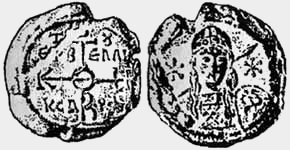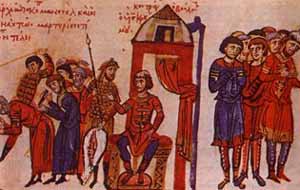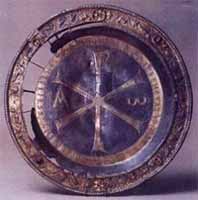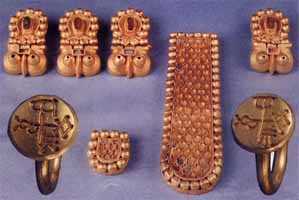Drawing on the written, sphragistic and archeological sources we come to the conclusion that even the first Bulgarian rulers established their identity in front of their subordinates and in front of the world in two ways: On one hand with khan's titles and their insignia /the horn and the scepter of khan Kubrat from the excavations at the funeral grounds in Malaya Perestepina have their correspondence in the kingdom of the Avar's khans/, which were characteristic of the barbaric cultural circle /that included the Huns, the Turks, the Avars and the Alans/, to which they were related by origin, and on the other hand, with the titles and the insignia of the patricians /chlamys, cingulum, codicilium/ to which they aspired through christening in Constantinople and through their friendship with Byzantium. The cingulum of the patrician and the Christian liturgical objects used at the funeral of Kubrat in Malaya Perestepina form new evidence in this direction.
Ring-seals with cross-shaped monograms of Kubrat and Orghana were also found there. The ring-seals confirm the kinship of Kubrat and Orghana and their titles of patricians, as well as the conversion to Christianity in Constantinople, that it is hinted in the written sources.
1. Golden sceptre from the grave of khan Kubrat in Malaja Pereshchepina, Ukraine. Mid-VII c. AD.;
2. Golden paten
3. Golden buckle of the patrician belt of khan Kubrat
4. Ring seal with a cross-like monogram BATOPXANOY ÏATPIKIOY; Ring seal with a cross-like monogram XOBRATOY ÏATPIKIOY; Golden crown Çëàòíà êîðîííà decoration from the grave of khan Kubrat.
Khan Asparuh /681-700/, Kuber and Altzek
The Christian beliefs of Altzek and Kuber is specially commented on and a question is put forward, whether they did not get converted before that - in the initial territories, from which they set out westwards leading the proto-Bulgarian groups - i.e. to the Bulgaria of Kubrat. An attempt has been made to highlight the fact that the treasure in Vrap, connected with Kuber, consists of Christian and liturgical items similar to those of the Kubrat's grave. At last the hypothesis is voiced that Asparuh could also have been converted in the Bulgaria of Kubrat, as well as the probability that he set out for the Lower Danube with the expectation to find a good reception in Byzantium and to receive the patricians title and regalia as a successor of Kubrat.
Tervel /700-718/ - khan of Bulgaria and Byzantine Caesar
 |
Lead seal of khan Tervel from the beginning of the VIII c. AD |
In comparison to his predecessors and his near successors, Tervel achieved in Bulgaria, as well as in Europe the highest recognition a barbaric ruler could possibly hope for, by receiving a title of Caesar and the regalia of the latter According to the written sources and the preserved lead seal he was inaugurated as a Caesar and a soldier, wearing a hemispherical helmet of a Caesar /the so called kamelaukion/, decorated with a Caesar s diadem /stephanos/, as well as wearing a golden chain armour, a spear with a golden top and a sagion /in such an armour he was depicted on the lead seal/. In addition he took the holy orders wearing of a crown-stephanos and a purple chlamys with a fibula /mentioned by Nicephorus and Teophanus/.
Following the Byzantine doctrine, decreeing that the Caesar should be mem-ber of the family of the emperor and a Christian /a regulation that was in force for all Byzantine dignitaries/, we explicitly state the opinion that Tervel was converted /that is evidently also from the text on the lead seal/ and suppose that the planned marriage to the infant daughter of Justinian II in the year 704 was really realized in the year 705 but perhaps it was not consumed.
Pagan khans. Krum /803-814/ and Omurtag /814-831/
Until now we have neither any sources, reliable enough, nor any authentic portraits of the Bulgarian khans after Tervel. But we can definitely assert that at a certain stage /perhaps after the death of Tervel or after the final fall of the clan Doulo from the khan's throne in the year 753/ at latest the Bulgarian rulers gave up the double standard for expression of their ruler's dignity. They gave up even the formal confession of the Christianity, which meant of course also renunciation from the Byzantine titles and regalia. The reasons for this-could be sought in several directions, but I think that the high legitimacy, which the Bulgarian state received after the con-clusion of a peace treaty with the Byzantine empire in the year 716 was decisive in this case. As a result of it the flirtation with Constantinople concerning the Christian religion and the Byzantine honorable titles, given to the khans in Pliska, became use-ful. Between the middle of the VII and the middle of the IX century most live was the question about the political legacy of the Avars, especially the titles and the insignia of Avar's khagans as their state fell in a deep crisis. The wish of the Bulgarian rulers to displace them from the top of the royal hierarchy of the barbaric world /the position of the Avar's khagan among the barbaric rulers was roughly like that of the emperor's in Constantinople after the Christian rulers/ did not harmonize with the low position, assigned to them on the hierarchy of the Byzantine-Christian world. That is why it could be supposed that in the VII century the pagan khans in Pliska wore attire and regalia similar to those of the Avar's rulers.
 |
Depiction of khan Omurtag and his sons in a miniature from the Madrid copy of Skylitza (XII c. AD) |
Furthermore the established traditions by Tervel together with the remarkable victories over the Byzantines, the Avars and the Arabs during the reign of Krum and Omurtag supposed borrowings from Byzantium, but not so much in terms of the titles and the religion as in terms of the palace ceremonies, attire and regalia. And it was not the attire and the regalia of the patricians and Caesar, but those of the emperor himself! But still we must not forget that Constantinople and the emperor were a criterion for all the other rulers; and any ruler, who wanted to compete with them, intentionally or not , closely observed the traditions in their palaces, ceremonies and attire. That is why some analogies between palaces with throne halls and ceremo-nies in Pliska and Constantinople of the early IX century should not be overlooked, notwithstanding the existence of opposition on religious base. However, at this stage we do not know for sure to what extent all this affected the attire and regalia of the Bulgarian khans. The portrait of Omurtag in Byzantine royal regalia on two medallions as well as some evidence about the influence of the palace ceremonies in Constantinople on the ceremonies in Pliska /especially upon the abathrone - wooden ceremonial alcove/ also give grounds for the assumption of some influence regarding the insignia. Judging from some miniatures in Scylitzes Matzytensis it could be asserted with a considerable degree of certainty that the long scaramangion with double "hussar" buttoning on the breasts appeared as a main element of the attire /one of the attire/ of Krum and Omurtag.
··· HOME ···
 Insignia and attire of the rulers of the First Bulgarian kingdom after the conversion to Christianity (864-1018)
Insignia and attire of the rulers of the First Bulgarian kingdom after the conversion to Christianity (864-1018)
 Insignia and attire of the Bulgarian rulers during the period of the Second kingdom (1185-1396)
Insignia and attire of the Bulgarian rulers during the period of the Second kingdom (1185-1396)
 Insignia and attire of the wives of the medieval Bulgarian rulers
Insignia and attire of the wives of the medieval Bulgarian rulers
 Insignia and attire of the Bulgarian high ranking dignitaries in the Middle Ages
Insignia and attire of the Bulgarian high ranking dignitaries in the Middle Ages
 About the treasure of Preslav and the insignia and the adornments of the noblest Bulgarian aristocrats during the Middle Ages
About the treasure of Preslav and the insignia and the adornments of the noblest Bulgarian aristocrats during the Middle Ages
 2.
2. 3.
3. 4.
4.
 2.
2. 3.
3. 4.
4.
Insignia and attire of the rulers of the First Bulgarian kingdom after the conversion to Christianity (864-1018)
Insignia and attire of the Bulgarian rulers during the period of the Second kingdom (1185-1396)
Insignia and attire of the wives of the medieval Bulgarian rulers
Insignia and attire of the Bulgarian high ranking dignitaries in the Middle Ages
About the treasure of Preslav and the insignia and the adornments of the noblest Bulgarian aristocrats during the Middle Ages